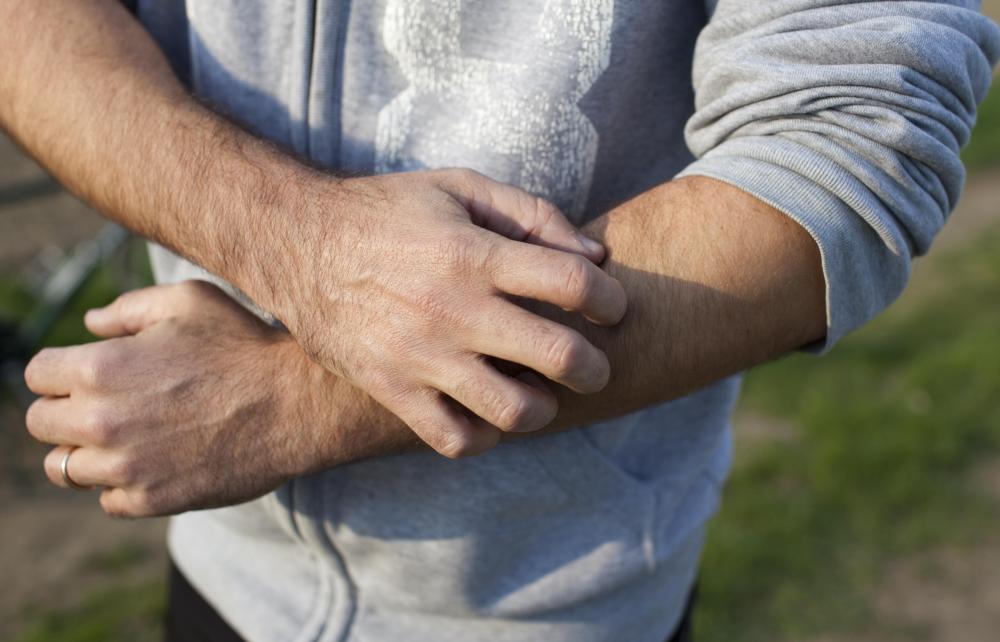At TheHealthBoard, we're committed to delivering accurate, trustworthy information. Our expert-authored content is rigorously fact-checked and sourced from credible authorities. Discover how we uphold the highest standards in providing you with reliable knowledge.
How do I Treat Poison Oak?
Poison oak is a plant of the genus Toxicodendron, along with poison ivy and poison sumac. Its leaves and branches produce an oil called urushiol that can cause a severe allergic reaction called contact dermatitis. A person who touches or rubs against the plant usually develops an itchy, red, blistering rash on the skin that can be uncomfortable. In most cases, people can treat poison oak at home in less than two weeks by washing the skin with mild soap and water, cooling the skin with ice and lotions, and applying topical hydrocortisone cream. Doctors treat severe or persistent cases of poison oak with prescription antihistamines and steroids.
Despite its name, poison oak is not closely related to the oak tree. It grows in nature as a small leafy vine or shrub at the base of larger trees and plants. Urushiol gets on the skin when a person touches the leaves or accidentally rubs up against the plant. The oil can also adhere to clothing and can be transferred to the skin by touching the contaminated material.

A person who realizes that he or she has just touched poison oak can sometimes avoid the development of a rash. Scrubbing the area with soap and water may be able to treat poison oak and remove traces of urushiol before it can chemically bond to the skin. Thoroughly washing the affected body part is only effective, however, if it is performed within about 15 minutes of coming into contact with poison oak.

If a rash does begin to develop, an individual should still wash the area to help prevent bacterial infections. Within the first few hours of a reaction, the skin typically becomes extremely red and itchy. Doctors strongly suggest that people avoid the temptation to scratch, as doing so usually worsens irritation and increases the chance of infection. Instead, people should treat poison oak by applying cold water and ice to the skin to relieve itching and burning sensations. Lotions that contain calamine, oatmeal, or aloe can also cool the skin and ease symptoms.

An individual can continue to treat poison oak at home by taking over-the-counter oral antihistamines and applying a topical corticosteroid cream, such as hydrocortisone. Antihistamines and creams can further reduce itching symptoms and help people get to sleep, though they do not actually shorten the healing time of the rash. With careful poison oak treatment, most cases are relieved in about two weeks. If symptoms persist for more than two weeks or cause serious discomfort, an individual typically should schedule an appointment with his or her doctor.

A physician can treat poison oak with high-strength oral and topical antihistamines. He or she may choose to manually drain large blisters if they are sensitive to the touch. In a severe case, the doctor can administer an oral steroid called prednisone that works by halting the immune system's response to poison oak, thereby stopping further inflammation. Medical treatment is generally effective at relieving the rash within a few days.
AS FEATURED ON:
AS FEATURED ON:

















Discussion Comments
@wesley91: There are commercial herbicides such as Brush-B-Gone and Roundup that can be effective in killing poison oak. However, it doesn’t always work because the root system will often come back.
In those cases, you can physically remove them.
Be sure to wear protective clothing including thick gloves, long sleeves and full length pants. Use pruning shears to cut the plant back and immediately put the trimmings into a heavy duty trash bag. Loosen the soil around the base of the plant with a shovel. Grab the plant by placing both of your hands as close to the roots as possible and pull it from the ground. Place that inside the garbage bag.
You need to cover the area where you pulled the poison oak up with mulch, tarps, or newspapers to smother any seedlings.
I have poison oak in the woods right outside my house. What is a good poison oak killer? I have tried several things but it just won't go away.
@wesley91: Usually, poison oak can be identified by its leaves. In the springtime, the leaves are shiny red, turning to a green color as they mature. It will yield small clusters of greenish-white flowers. In the fall, the foliage changes from green to red and orange. It is a deciduous, woody plant and it loses its leaves in the winter.
The leaves usually grow in a group of three on a shared stalk. The leaflets are rounded at the tips. The surface of the leaf can appear to look a little hairy or glossy. They are usually 1 to 4 inches in length with toothed edges.
What does poison oak look like?
Post your comments